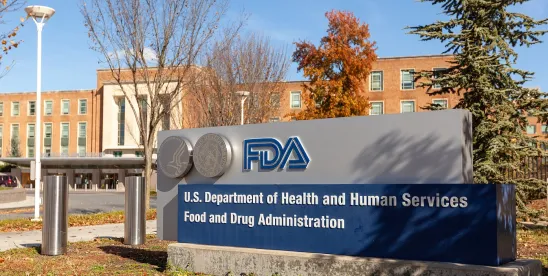On May 21, 2024, the Center for Biologics Evaluation and Research (CBER) at the U.S. Food and Drug Administration (FDA) published a warning letter issued to Akan Biosciences, Inc. (Akan) for unresolved inspection observations following a back-and-forth between FDA and Akan. The Form FDA-483 highlights a number of observations about 585 vials of an Akan product, but the warning letter spends considerable time beforehand covering reasons why Akan’s product does not meet the requirements of 21 C.F.R. § 1271.10(a), which qualify certain human cells, tissues, or cellular or tissue-based products (HCT/Ps) for exemptions from key FDCA requirements, including premarket review. Akan’s product is an adipose derived, stromal vascular fraction (SVF) cellular product for allogenic use with the brand name Ayama™.
This warning letter is a quintessential example of FDA’s enforcement priorities for these products, and highlights the ongoing scrutiny placed on HCT/P manufacturers. We will have some analysis and takeaways later – including possible reasons for why FDA opted to issue a Warning Letter as opposed to an Untitled Letter – but first, let’s go through the details of the letter and what FDA highlighted:
HCT/P Regulation:
Our prior blog posts have taken a detailed look at the use of HCT/Ps and FDA’s risk-based regulatory framework for the same,[1] but it is important to note that FDA views this area as “a complex and rapidly evolving field.”[2] In short, as a reminder, if an HCT/P meets all of the following criteria, then the manufacturer can avoid the time-consuming and costly premarket review and approval process:
- The HCT/P is minimally manipulated;
- The HCT/P is objectively marketed for intended uses in the recipient that are consistent with its normal function in the donor’s body (i.e., homologous uses);
- The HCT/P is not combined with another article (with some limited exceptions); and
- The HCT/P either:
- (1) does not have a systemic effect and is not dependent on the metabolic activity of living cells for its primary function; or
- (2) does have a systemic effect or is dependent on the metabolic activity of living cells for its primary function, and is for:
- (a) use in the same individual who was the source of the tissue or cells;
- (b) use in an individual who is a first- or second-degree blood relative of the donor of the tissue or cells; or
- (c) reproductive use.
The purpose of this test is to help FDA in differentiating HCT/Ps that pose minimal public health risks from those higher-risk products which should be subject to clinical trials and premarketing review by the agency. Accordingly, HCT/Ps that do not meet the above criteria – and do not fall into one of the enumerated exceptions under 21 CFR § 1271.15 – are considered to be drugs, devices, and/or biological products regulated under Section 351 of the PHS Act and the Federal Food, Drug, & Cosmetic Act (FDCA).[3]
Without a doubt, the two most frequently discussed and cited criteria are minimal manipulation and homologous use. In evaluating minimal manipulation, FDA looks at the processing of the product and evaluates the extent of steps involved in transforming the HCT/P from donor specimen to finished product. Over time, the agency has provided a number of examples of minimal or more-than-minimal manipulation;[4] however, FDA has also explicitly left this area open for innovation, stating that “subsequent accumulation of clinical data and experience about a particular process” may change the agency’s assessment.[5]
For homologous use, FDA considers the manner in which the product is marketed. In particular, the focus here is whether the HCT/P’s intended use is to “perform[] the same basic function or functions in the recipient as in the donor.”[6] For this step, FDA considers the manufacturer’s objective intent, as determined by product labeling, advertising, expressions of the manufacturer’s representatives, and circumstances surrounding distribution.
Here, FDA’s conclusion on the inapplicability of 21 CFR § 1271.10(a) focuses on these two subsections. FDA simply states, without explanation, that Akan’s product fails the minimal manipulation prong of the regulation because processing “alters the original relevant characteristics of the adipose tissue related to its utility for reconstruction, repair, or replacement.” On the homologous use prong, FDA provides more context. FDA notes that the product’s basic function of “cushioning and support for … skin and internal organs, storing energy in the form of lipids, and insulating the body” is not what Akan advertises on its website—“to repair, reconstruct and replace your skin tissue.”
For these two reasons, FDA found that Akan’s product does not qualify for exemption under 21 C.F.R. § 1271.10, and therefore is regulated as a drug and biological product. FDA further noted that Akan did not possess a valid biologics license or investigational new drug application for its product. Interestingly, unlike past warning letters for unapproved non-exempt HCT/Ps, FDA did not explicitly state that Akan’s actions “violated the FD&C Act and the PHS Act.”[7] Perhaps this was an oversight on the agency’s part, but nonetheless stands out among past enforcement.
483 Observations:
In addition, FDA’s letter also cited “significant violations” of HCT/P donor screening and eligibility testing and GMP requirements. Among other things, FDA’s inspection revealed that Akan utilized inadequate methods to test and screen donors for communicable diseases. For example, FDA stated that Akan’s “Donor Screening Questionnaire” form failed to “address certain risk factors for relevant communicable disease agents and diseases, including . . . a donor’s risk of having West Nile Virus (WNV), among other risk factors.” In so doing, FDA provided an extensive list of examples of risk factors that should be included on such forms. With respect to GMPs, FDA further cited Akan for “[f]ailure to establish written procedures for production and process control” and “[f]ailure to have an adequate system for monitoring environmental conditions in an aseptic processing area.”
Takeaways:
This warning letter serves as yet another a reminder to HCT/P manufacturers of FDA’s core enforcement priorities with respect to cell and tissue products. While FDA has issued a number of guidances over the years to help de-mystify the elements of 21 C.F.R. Part 1271 (also referred to as the “tissue rules”), the primary goal has always remained the same: prevention of the introduction, transmission, and spread of communicable disease. In achieving this goal, FDA’s tissue rules focus on three main areas:
- preventing unwitting use of contaminated tissues with the potential for transmitting infectious diseases such as AIDS and hepatitis;
- preventing improper handling or processing that might contaminate or damage tissues; [and]
- ensuring that clinical safety and effectiveness is demonstrated for tissues that are highly processed, are used for other than their normal function, are combined with non-tissue components, or are used for metabolic purposes.”[8]
Perhaps unsurprisingly, then, FDA keys on each of these concepts in its letter to Akan. The opening discussion of minimal manipulation and homologous use serves to further point #3, and reveals FDA’s assessment that products like Akan’s should be subject to greater oversight. Then, in addressing Akan’s inadequate donor screening and testing procedures, FDA focuses on point #1 and the prevention of unwitting use of potentially contaminated tissues. Lastly, the discussion of Akan’s GMP deficiencies focuses on the final point – prevention of improper handling and processing.
Furthermore, this letter also provides some helpful context for the types of activities that will lead to a Warning Letter versus an Untitled Letter. In terms of HCT/P enforcement, CBER has historically kept a close eye on HCT/Ps. Indeed, this year alone, CBER has issued six letters to HCT/P manufacturers. In reviewing recent letters issued by CBER, we see that the agency tends to issue Warning Letters where donor screening and testing and/or GMP deficiencies are revealed during an inspection. In contrast, Untitled Letters typically focus more on the characteristics of the product as described in publicly available marketing claims made on company websites and social media pages.
Adding to this, FDA has also advised that Warning Letters may be warranted for HCT/Ps where there are violations that “meet the threshold for regulatory significance suggesting that systemic problems exist within one or more areas of the firm’s operations.”[9] This could include “continuing pattern[s] of non-compliance, a failure to correct significant deficiencies noted during a previous inspection, or the deficiencies pose a serious threat to the public health, and voluntary action is either not appropriate or can not be readily accomplished.”[10] Aside from these examples, the “threshold for regulatory significance” is not clearly defined. However, based on past letters, unresolved issues with donor screening and testing and GMP deficiencies certainly appear to meet this threshold.
According to FDA, Akan was provided an opportunity to response to these observations, however, FDA found this response to be insufficient. Among other things, although Akan initiated a voluntary product recall of its Ayama™ product, FDA deemed that the product recall documentation report disavowed any specific safety concerns regarding the product and Akan failed to provide FDA with details regarding the remaining product on hand. Further, FDA noted that Akan’s “revised process validation report for Ayama lack[ed] significant documentation to assure that the product has the identity, strength, purity, and quality it purports or is represented to possess.” Accordingly, the agency’s motivation for issuing a Warning Letter was likely due to (1) the types of issues identified (i.e., donor screening/testing and GMPs), and (2) a failure to rectify these issues in an adequate manner, thereby suggesting systemic problems within the firm’s operations.
All in all, this letter highlights the continued importance of not only strict adherence to FDA’s tissue rules, but also taking a step back and remembering the bigger picture for why FDA has crafted and implemented these regulations. Further, if presented with a 483, companies should carefully consider what corrective actions will adequately address and alleviate the agency’s concerns. FDA’s tissue rules were intended to carefully balance the interests of innovation in regenerative medicine and the prevention of transmission of communicable disease, however, CBER has made clear that it is not afraid to take action where there are obvious signs of noncompliance. In light of this, manufacturers should be mindful of FDA’s goals when determining a commercialization and manufacturing strategy for their product.
FOOTNOTES
[1] FDA Cracking Down on Unapproved HCT/Ps with Fourth Untitled Letter of 2023; FDA Issues First Untitled Letter of the Year to HCT/P Manufacturer.
[3] 21 C.F.R. § 1271.20.
[4] See, e.g.¸ 66 Fed. Reg. at 5457; Regulatory Considerations for Human Cells, Tissues, and Cellular and Tissue-Based Products: Minimal Manipulation and Homologous Use Guidance, at 15.
[5] See 63 Fed. Reg. at 26748.
[6] 21 C.F.R. § 1271.3.
[7] See, e.g., Warning Letter to Signature Biologics, LLC (Sept. 18, 2023); Warning Letter to Row1 Inc. dba Regenative Labs (June 21, 2023); Warning Letter to Stratus Biosystems, LLC dba CellGenuity Regenerative Science (June 5, 2023); Warning Letter to RenatiLabs Inc. (June 1, 2023).
[9] See U.S. Food & Drug Admin., Compliance Program Guidance Manual: Inspection of Human Cells, Tissues, and Cellular and Tissue-Based Products (HCT/Ps) 7341.002, at 17 (emphasis added).
[10] See id. at 16, 18.




 />i
/>i

